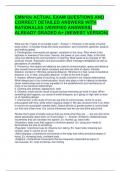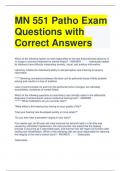CMN10v ACTUAL EXAM QUESTIONS AND
CORRECT DETAILED ANSWERS WITH
RATIONALES (VERIFIED ANSWERS)
ALREADY GRADED A+ (NEWEST VERSION)
What are the 7 types of nonverbal cues? - Answer-1. Kinesics: is the study of human
body motion. It includes things like facial expression, eye movement, gestures, posture,
and walking speed.
2. Paralinguistic: how words are spoken, variations in the voice. Pitch which is the
highness or lowness of the voice. Volume, the power of your voice. Rate, is the third
vocal cue affecting the communication of meaning. Most speak at an average of 150
word per minute. Articulation and pronunciation affect message intelligibility as well as
perceptions of credibility.
3. Proxemics: how space and distance are used in communication, space and distance
also reveals how we feel about ourselves and what we think of others. Intimate
distance: contact to 18inches, personal distance: 18inches to 4 feet, social consultative
distance: 4 to 12 feet, and public distance: 12 feet to the limit of sight.
4. Haptics: different types of touching, is usually involved in our closest relationships.
While always part of our communication, touch also plays a role in helping us develop
closer relationships and is a key ingredient in the establishment and maintenance of
many of our personal relationships.
5. Clothing and artifacts: appearance, style
6. Olfactics: smell and the recall of good and bad memories go hand in hand. When
something bad happens, our sense of smell sharpens, as if going on high alert to warn
us of impeding danger.
7. Chronemics: is the study of how we use time to communicate. Come of us are
preoccupied with time, while others regularly waste it. We also structure time in an effort
to ensure we accomplish needed tasks. Status affords us greater power to control both
our time and others time. Our culture influences how we use and think about time.
Review the 5 types of bodily cues so that you know what they are . . . but you will not be
asked specifically about them on Examination 1. - Answer--Emblems: deliberate body
movements that can translate into speech. Ex: thumbs up, wave hello
-Illustrators: body cues that support or reinforce speech. Ex: using your hands to
demonstrate the size of something
-Regulator: intentional cues to influence turn taking. Ex: head nods, breaking eye
contact, raise in volume of our voice.
-Affect displays: unintentional movements of the body that reflect emotional states of
being. Ex: slumping body, confident body
-Adaptors: unintentional movements that are frequently interpreted as signs of
nervousness. Ex: nose scratches, hair twirling
, What is the purpose of the paper (on the first page of the article): Profanity article -
Answer-this paper looks at profanity as a source of communication power and control
and, in this context, considers the implications of usage differences between the sexes.
Note in the literature review from the 2nd to 4th pages of the paper that there have been
various studies associated with the use of language by the different sexes. There won't
be specific questions about them. - Answer-1. Otto Jespersen: Wrote that women's
language differs from that of men in the selection of vocabulary and formation of
sentence structure. Men swear more, use more slang, and use puns more. Women in
contrast avoid rough language, use greater euphemisms, and generally have more
limited vocabularies. Men construct sentences with more imbedded clauses, and
women construct sentences as "a string of pearls"
2. Opinions of scholars based on logic and reason: Jespersen claimed that women of
his day did not swear as much as men did nor did they use much slang. Lakoff argues
that relative forcefulness of these expletives may be a function of "how strong one
allows oneself to feel about something, so that strength of an emotion conveyed in a
sentence corresponds to the strength of the particle.
3. Empirical research based on subject's perception of male and female language
stereotypes: found that subjects of both sexes who were asked to identify cartoon
captions as male or female speaker, characterized women's speech according to the
stereotypes of "stupid, vague, emotional, confused, and wordy" Male speech on the
other hand, was identified to be logical, concise, businesslike, and in control.
4. Empirical research on actual male and female language samples: found that females
used a greater number of words implying emotion and feeling, while males selected
words relating to time, space, quantity, and destructive action. Barron's research with
actual language samples revealed that language used by women appears to be more
"person oriented" rather than "thing oriented" as in male usage. They also found that
males refer more to events, while females more often reference other people. Males
were more likely to interrupt females.
Lakoff writes: that where men often use more direct questions in speech, women more
often provide ta
Review specific questions of the study, the method, and the results - Answer-- The
questions poised for this stud deal primarily with sex differences in the usage and
perceptions of profanity.
- The method: the sample consisted of 135 undergrad students (61 females and 74
males) each completed a questionnaire which requested information about hometown
setting, family demographic, religious orientation, media consumption patterns, and
other daily habits. The respondents were asked to use a four- point scale (1=never, 2=
rarely, 3= occasionally, 4= frequently) to assess their own profanity use in everyday
conversations and use by friends.
- Results: in the initial series of questions, female respondents reported significantly less
use of profanity than reported by males. In all but a single instance, female respondents
said that they felt the use of profanity would be less appropriate than males said it would
be in various circumstances





